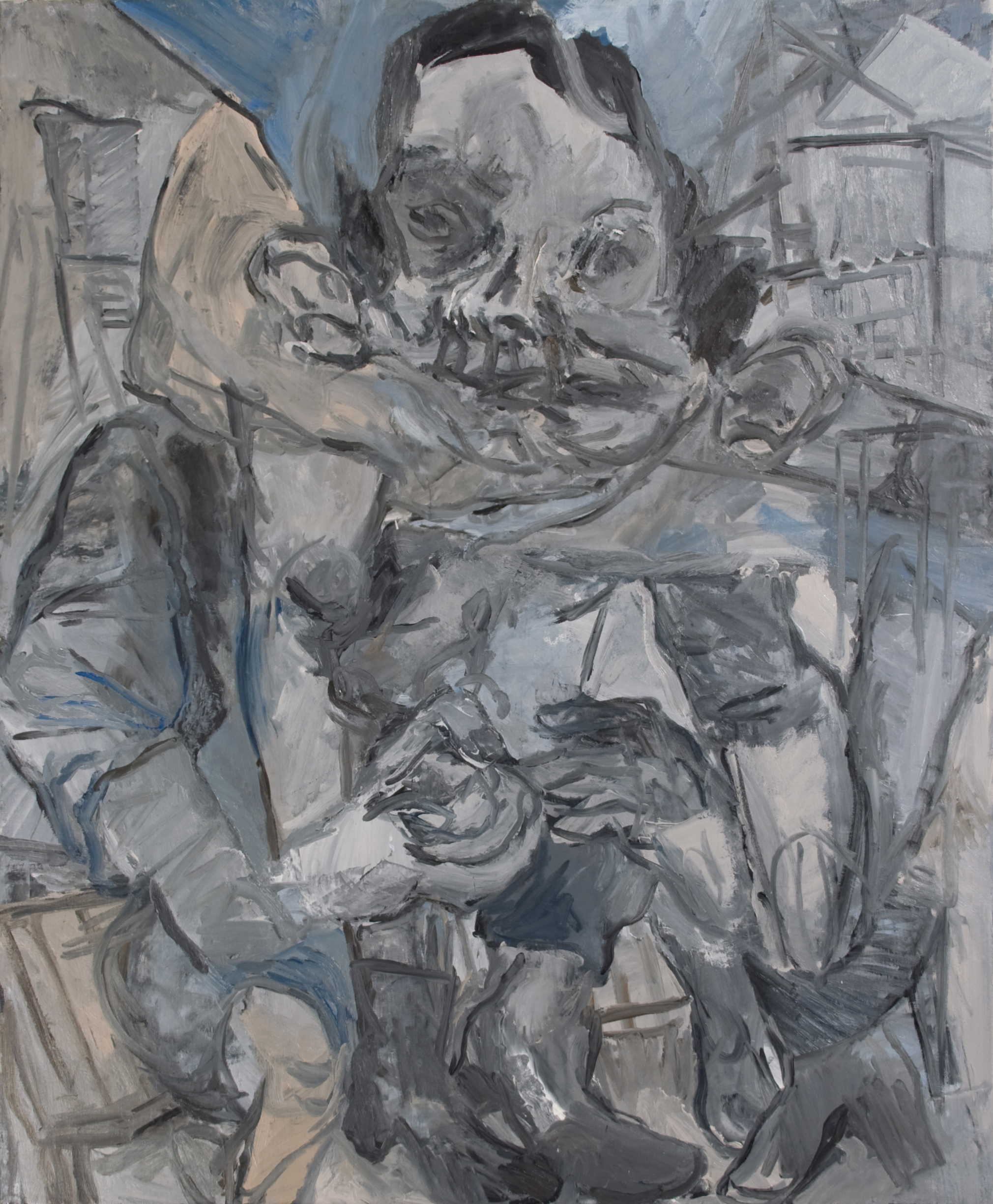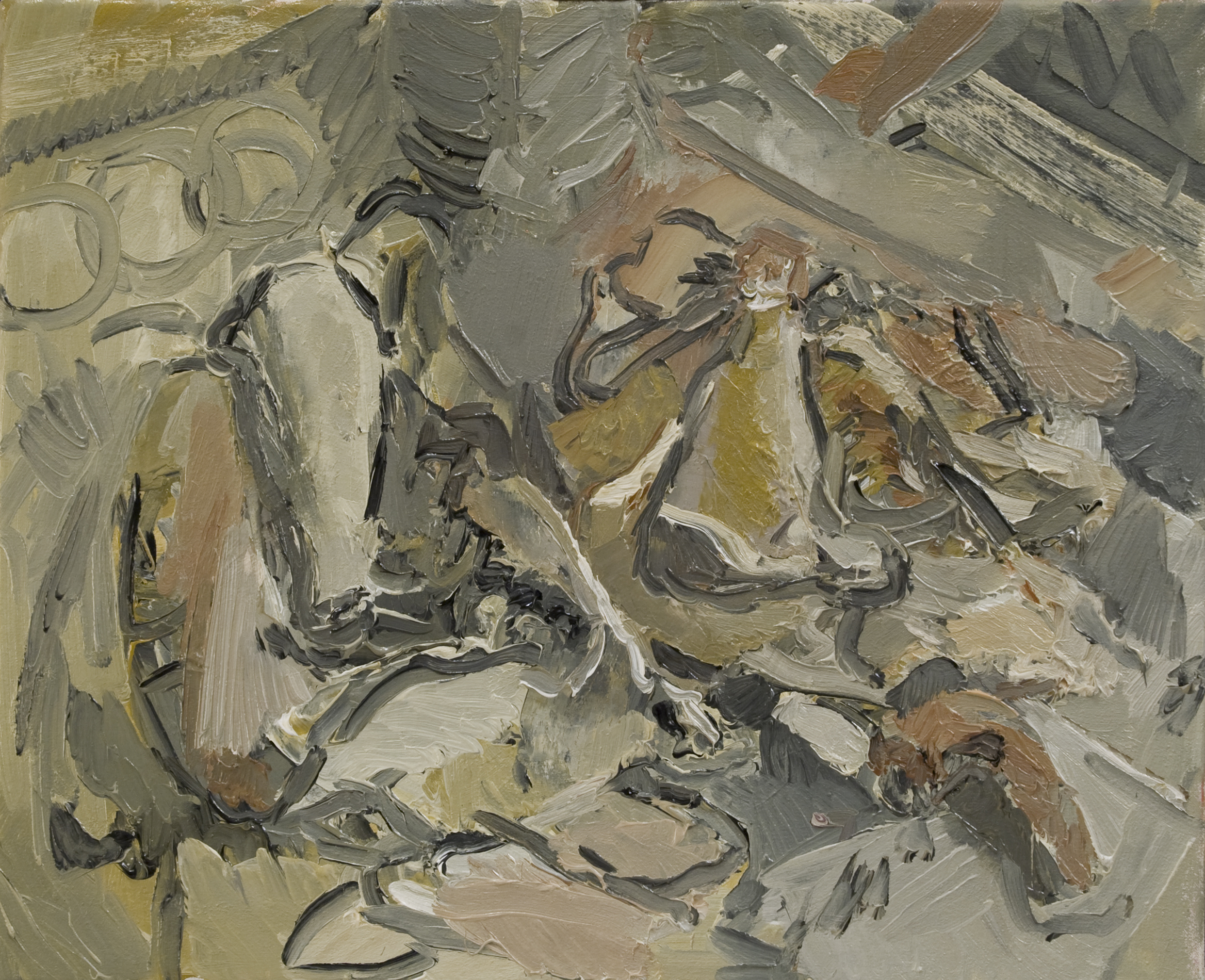 ‘The Idiot’. New Paintings and Works on Paper, brings together a series of new works by London-based Spanish artist Jaime Valtierra. They include a recent cycle of Paintings and Drawings (2012 – 2014), and a group of prints produced during an Arts Residency in Florence in 2014.
‘The Idiot’. New Paintings and Works on Paper, brings together a series of new works by London-based Spanish artist Jaime Valtierra. They include a recent cycle of Paintings and Drawings (2012 – 2014), and a group of prints produced during an Arts Residency in Florence in 2014.
The complete show presents a departure from previous works and confronts the viewer with the artist`s renewed engagement with experimentation and direct expressive means within his own practice. They bring forward a hazy and intense vision of the artist`s own imagined universe, and emphasize an emotional exploration of his experiences and relationship with the world.
The works are a raw confrontation with an intuitive vision in flux, and exist (specially in the case of the paintings) as a sustained struggle to express and capture this personal insight. “To reject the image as something given or as an idea to be executed, and to conceive it instead as an impossible reality, an impossible reversal towards this fleeting feeling and its improbable depiction”.
This journey is what the artist describes as the will of the Idiot, an ongoing deciphering guesswork of the meaning of reality and its precarious “translation” into the “language” of painting trough his own power to imagine and verify its validity. The resulting body of work opens a window into a bizarre space where distorted / fragmented figures negotiate their existence in a hostile and intrusive environment.
Private View: Thursday 28th of May
First Thursdays Late Opening: 4th of June
Performance Event. Adolfa`s Cave.: Friday 12th of June
Jaime Valtierra lives and works in London. His work centres around the creation of imagery which follows a personal, shattered and subjective understanding of human behaviour and interpersonal relations. He works with painting, drawing, printing, digital media, installation and performance. Recent Projects and Exhibitions include: ‘Ficino`s Cave’. Barbican Fish Island Labs, London; ‘Magma Collective’. Biagiotti Projetto di Arte, Florence ; ‘Edge of the Land’. Hundred Years Gallery, London; ‘Illusions of Reference’. Psycological Art Circus, London; ‘Cuidad Memoria’. Espacio Islandia, Madrid.
www.jaimevaltierra.co.uk www.mnemoniccity.com
‘The Idiot’: Listen Jaime Valtierra in conversation with Montse Gallego.
——————————————————————————————————————————————————————————————————————————
DEATH OF A SYMBOL, DECOMPOSITION OF A PROCESS
By Pascal Ancel Bartholdi
I once wondered why the painter ever makes a mark in the emptiness, what he /she intends to remember because this initial gesture stands as an entrance into a territory that demands visibility, no matter how indefinite, like dreams. And how is it possible in the first place? But we are not talking about a point of focus, quite the contrary. We could indeed speak of a phenomenological field as it is suggested in Deleuze ’s concept: “Plane of Immanence”. Jaime Valtierra ’s new works epitomize such a ‘condition’. There is no fixity here, yet, he arrests one moment like the spearhead of a battalion. There is no escape for form to the land of the ‘tableau’, for this artist denies the dictatorship of the ‘finished product’, i.e., as a cage of irreducible linear statements. We cannot fathom an end to the process of creation. As Deleuze explains, the “plane of immanence” encompasses death as an active participant in the act of transformation. In this work, what becomes demonstrated is the nature of destruction lying within every molecular impulse towards life and without the truth of which no creation could be realized. We discover the possibility of decomposition within the margins of compositional tactics, the hazards of a liquid underworld where Valtierra leaves traces in strategic places although none have been fixed. Relativity and reciprocity rule a universe in flux until the new body begins to make sense, a sense proper to life, an antithesis to the formalism of imitative artifice.
Two main themes are evident; one is the process and place of making. The Studio is a kind of doppelganger self-portrait enunciating the death of portraiture as we know it. Its completion is contradicted by a sense of imminent disintegration. As with all the other recent works, a minimal palette was used in extreme opposition to the rich color saturation of previous ones. The second theme, integral to The Studio, lies in The Digger. We are in the realm of the fool, the unconscious. His paintings remind me somehow of ‘écorchés’; the surface of preconception has been ripped away. He replicates himself, to arrive at what feels like the pulse of the image. He takes them apart, as if taking himself apart, reconstructing, yet never as a builder, but rather as a demolisher, for before getting to the outer edge of the original form awaiting his discovery, he must take down entire walls of conventional visuality. Such a process stems from the foundation of the art, that is, alchemy, “Our stone(…) is composed of four elements, it must be divided and its limbs taken apart(…)and then transformed into the nature that is within it.”(Rosarium Philosophorum).
Talking Head is the artist, the rational intervention, and the conscious’ apparent victory. There is no model; this is a return to what happened before what was known, the ‘nigredo’ of transmutation. Nicolas Valois tells us in The Mystery of Cathedrals by Fulcanelli: “ He who transmuted first had no books, he followed nature, observing how and with what materials she works”. The ‘salvation’ resides in the materiality of experience, “satisfied in the absurdity”. As Jaime points out, and quoting Francis Bacon: “Some paint comes across directly onto the nervous system”. It seems Jaime Valtierra has fomented a dramatic existential rebellion against insubstantiality to unearth what he calls “the root of desire”. Anna may stand as the apex of this research in my view, a mother and an ogre, disfigured and omnipotent, blending with the air yet in a nightmarish sense, materializing before us.
Jaime unleashes the man out of rational time to dismantle the illusion of the pre-conceptual persona, the man Deleuze referred to as ‘the idiot’: “Something in the world forces us to think. This something is an object not of recognition but of a fundamental encounter. What is encountered may be Socrates, a temple or a demon. It may be grasped in a number of affective tones: wonder, love, hatred, suffering. In whichever tone, its primary tone is that it can only be sensed.”(Gilles Deleuze, Deleuze, G. Difference and Repetition). Is Jaime extricating this indefinable tone by departing from a certain color convention found in his earlier pieces? “ It is like dismantling a machine while it is still running, this means there is no machine”. What we find instead of logic and obvious seduction is a kind of ontological battlefield where the grotesque takes hold from the depth as it did in Goya’s Black Paintings so familiar to him. It has echoes of Not with Love but with Fear, 2013, where the artist’s head splits and doubles itself, a prelude to his present haunting images. Instead of the figure as fact, Jaime turns it into “an experience of space”, and insinuates space into the surface. We are entering Romanesque evocation, seeing from different perspectives on one plane, “it is so awkward it is right”, Jaime says as he looks at medieval illuminations.
We glimpse into a world that is not yet one, a meaningful dissolution where implosion and explosion occur simultaneously. We are certain of nothing, we are left to swim at large encountering ourselves, the poetry of nature beyond the superfluous aid of symbols, for symbols cannot survive in the chaos of life, even on canvas and paper. Jaime tells me it amounts to un-explaining, where the story cancels itself out, where the building block of imagery is nothing but confusion and drawing is as important as painting, a form of inner breathing, a mastication and a contemplation, a comprehending and apprehending of the dark and the light, the actors and the props.
The result if we can call the paintings and drawings thus, for they seem to allude pin pointing and definition, is soft and violent, grotesque and poetic, sexy and inhuman, a unifying muted principle, a return, as Jaime tells me, to the feeling of an image against the false safety of logic. “In order to make the accidental, all you already know must be dissolved.” He carves into the substance, creates volumes out of power relations between uncertain lines, makes gestures into spatial mediators, laying sub-layers bare, destabilizing planes out of focal absolutism. We are left to our own devices, staring into another kind of cosmos, perceiving what we imagine as we would, gazing at the impenetrable movement of foliage in the moonlight. We can no longer imagine a painting to be the sole effect of a fantasy; this work reveals the imagination of the reel.
Copyright © Pascal Ancel Bartholdi 2014


